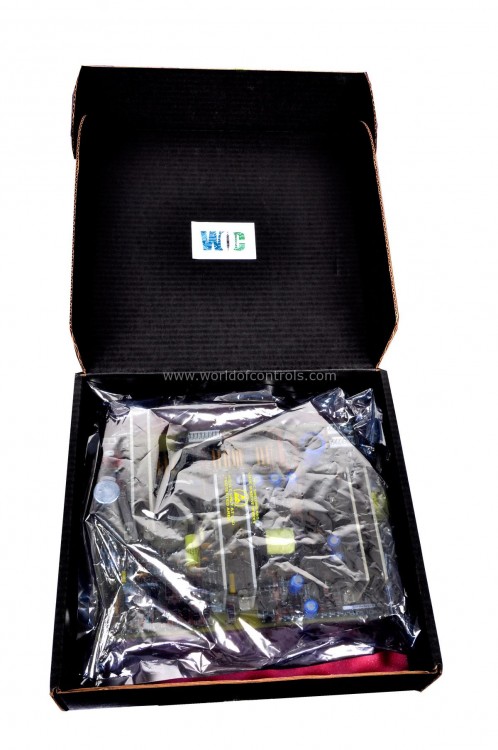SPECIFICATIONS
Part Number: DS200TCDAF1ACL
Manufacturer: General Electric
Series: Mark V
Product type: Software PROM Set
Availability: In Stock
Country of Manufacture: United States (USA)
Functional Description
DS200TCDAF1ACL is a Software PROM Set designed and developed by GE. It is a part of the Mark V control system. EPROM requires external programming equipment, such as an EPROM programmer, to write or reprogram data onto the chip. This process involves using a specialized programming device to transfer data onto the EPROM.
Features
- EPROM utilizes UV light to erase its stored content. The EPROM chip features a rock crystal window at the top that allows UV light to penetrate and erase the memory cells' content.
- The cell size in EPROM is notably large compared to more modern memory technologies. Each memory cell within an EPROM typically occupies a relatively larger physical area.
- EPROM is an advanced iteration or modern version of PROM (Programmable Read-Only Memory). While both are programmable, EPROM offers the additional feature of erasability, which is not present in PROM.
- Once an EPROM's memory content is erased using UV light, it becomes possible to reprogram new data onto the chip. This erasure step is necessary before new data can be written onto the EPROM.
- Transistors within an EPROM typically require a relatively high voltage, commonly around 12.5 volts, to facilitate certain operations such as erasing or programming the memory cells.
- EPROM uses the hot electron injection technique during its programming process. This method involves the generation of high-energy electrons that are injected into the floating gate of the memory cell to alter its state, representing programmed data.
- The erasure process for an EPROM typically takes around 15 to 20 minutes to effectively remove the stored content from the memory cells using UV light exposure through the crystal window.
- To erase and reprogram the computer's BIOS, the EPROM chip needs to be removed from the computer's circuitry. It must be taken offline to undergo the erasure process and then reprogrammed using external programming equipment before being reintegrated into the system.
System Master Trip Circuit
- External Trip Signal Reception: Upon receiving an external trip signal, the 4's trip circuit initiates the de-energization process. This action propagates through various interconnected circuits within the system.
- De-Energization of Voting Contacts Circuit: The external trip signal prompts the de-energization of the voting contacts circuit. These contacts are crucial elements in the system's redundancy setup, where multiple inputs or signals are compared or 'voted' upon to ensure a reliable trip decision.
- Impact on the 24 V dc Protective Bus: The de-energization of the voting contacts circuit subsequently affects the internal 24 V dc protective bus. This bus serves as the power supply source for several critical components within the protection system.
- Supply to Primary Trip Relays (PTRs) and Emergency Trip Relays (ETRs): The 24 V dc protective bus, now affected by the de-energization process, supplies power to the primary trip relays (PTRs) and emergency trip relays (ETRs). These relays play a pivotal role in interfacing with the turbine trip solenoids and initiating the trip sequence upon receiving the necessary signal.
- Functionality of PTRs and ETRs in the Master Trip Circuit: PTRs and ETRs together form the output segment of the Master Trip Circuit. They are responsible for executing the trip sequence and taking appropriate action in response to the received external trip signal.
- Role of Microprocessors on Protection Boards: The microprocessors present on these protection boards serve the purpose of monitoring the status of both hardwired and remote trip inputs. They continuously assess the state of these inputs for any abnormalities or trip signals.
- Independence of Actual Tripping from Processors: Although the microprocessors monitor trip inputs, it's crucial to note that the tripping action itself is independent of these processors. The trip sequence execution is a direct consequence of the relay actions and associated circuitry, ensuring rapid and reliable response times in case of a trip condition.
WOC is available 24x7 to assist you with any of your General Electric requirements. Please contact us by phone or email for pricing and availability on GE, Bently Nevada or Woodward parts and repairs.
FREQUENTLY ASKED QUESTIONS
What is DS200TCDAF1ACL?
It is a Software PROM Set designed and developed by GE
What happens when an external trip signal is received?
Upon receiving an external trip signal, the 4's trip circuit initiates a de-energization process, setting off a chain reaction within the system's circuits.
What is the role of the voting contacts circuit in the trip process?
The external trip signal triggers the de-energization of the voting contacts circuit, pivotal in a redundant system where multiple inputs are compared to ensure a reliable trip decision.
How does the de-energization of the voting contacts circuit impact the system's operation?
The de-energization of the voting contacts circuit subsequently affects the internal 24 V dc protective bus, the primary power source for critical components within the protection system.
What role do Primary Trip Relays (PTRs) and Emergency Trip Relays (ETRs) play in the system?
The affected 24 V dc protective bus supplies power to PTRs and ETRs. These relays are crucial as they interface with turbine trip solenoids, initiating the necessary trip sequence upon receiving the external trip signal.
